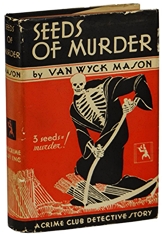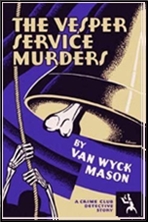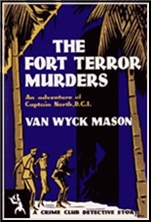Sun 1 Aug 2021
Mike Nevins on Mystery Writer F. VAN WYCK MASON.
Posted by Steve under Authors , Columns , Reviews[8] Comments
by Francis M. Nevins
Does anybody still read F. Van Wyck Mason? I began buying his books in my teens and accumulated a generous assortment of them over time but read very few if any until recent years. His first name was Francis, his middle name was pronounced Van Wyke, and he was born in Boston in 1897, although some print and Web sources give the year as 1901, which strikes me as wrong because that would have made him 15 or 16 at the time the U.S. entered World War I, in which he is said to have served.

He spent most of his early years in Berlin and Paris, where his grandfather was U.S. Consul General, and didn’t learn English until he was in his teens. After graduating from Harvard in 1924 he started his own importing business and traveled the world purchasing antique rugs and other objets d’art. As a fiction writer he debuted in 1928, appearing in many pulps but most often in Argosy, which published several of his historical adventure serials with titles like CAPTAIN NEMESIS, CAPTAIN JUDAS, CAPTAIN RENEGADE, CAPTAIN REDSPURS and CAPTAIN LONG KNIFE.
As these titles unsubtly suggest, he was a military kind of guy, serving in Squadron A of the New York National Guard and later in the Maryland National Guard. He was also something of an athlete, his favorite sport being polo, a subject which crops up in many of his novels and stories. During World War II he put his writing career on hold and returned to the military, rising to the rank of Colonel and the position of chief historian on General Eisenhower’s staff.
After the war he returned to fiction writing and eventually moved to Bermuda, where in 1978 he drowned. He was probably best known for a string of gargantuan historical adventure novels, beginning with THREE HARBOURS (1938), STARS ON THE SEA (1940) and RIVERS OF GLORY (1942), but here we are interested in his early crime fiction — not on its merits but because, as we’ll see shortly, it had a huge influence on one of the giants of the genre.
His first novel, SEEDS OF MURDER (1930), introduces his series character Captain Hugh North, an officer in Army Intelligence but never seen in uniform and obviously intended as an American Sherlock Holmes. Appropriately enough, he has a Watson who, like the original, happens to be a medical man, a doctor named Walter Allan.

North is visiting with Allan at Hempstead, Long Island, when both men are invited to dinner at the palatial home of Royal Delancey, a former Philippine plantation owner who made a fortune during World War I and afterwards, back in the U.S., bought into a firm of stockbrokers. Delancey’s version of Toad Hall is hit by a savage storm before dinner can be served. Then one of his house guests, who is also his brokerage partner, is found dead in his bathroom, seemingly having strangled himself with a strong chain.
But why was his apparent suicide note written on a piece of paper a quarter-inch shorter than the other sheets on his desk, and how could he have reached the hook on which the chain was hung by standing on a wire-and-enamel wastebasket too flimsy to support his weight?
Even stranger, why were three mysterious seeds found on the bathroom floor, arranged in a precise triangle? North keeps his counsel and doesn’t dispute the police verdict of suicide, but before dawn the next morning Delancey himself is stabbed to death with an exotic dagger in his bedroom, and three more of those triangularly arranged seeds are lying beneath his chair.
Among the suspects are Delancey’s mistress, his abused young wife and her brother (both of whom are near broke after having entrusted him with their money), a former neighbor who had also lost heavily by investing with Delancey, and a sinister Filipino butler who perpetrates lines like “‘Scuse if I speak slow. Me no spik English ver’ well.â€
At times the novel veers close to silent-movie melodrama, especially at the action climax where North disguises himself as a gypsy and sets a trap for the murderer in front of a disused Russian Orthodox church. But, unlike most of the subsequent books in the long series, this one is a genuine detective novel, rife with complexities, clues, conundrums, the works.
Mason seems to know his Philippine background but ridiculous is the best word for his notion of an inquest, held in the Delancey living room and culminating with the coroner’s jury indicting two suspects. The novel isn’t as scrupulously fair as, say, an early Ellery Queen, and its politically incorrect portrayal of Filipinos and gypsies — oops, my bad, we’re required today to call them Roma — make it an unlikely candidate for revival in the 21st century.
THE VESPER SERVICE MURDERS (1931) begins much as SEEDS OF MURDER did, with North on vacation and staying with his Watson at the palatial home of a nabob, but the prosperous Massachusetts mill town they’re visiting may perhaps owe something to the Poisonville of Hammett’s RED HARVEST (1929), crooked politicians, fat sloppy cops and all.

The city’s corrupt mayor is running for re-election against a Reform candidate who’s backed by North’s host, a wealthy old judge, and who’s courting his sponsor’s lovely daughter. After a tense conversation involving the judge, the rival candidates for mayor and a local businessman who’s also interested in the judge’s daughter, the mansion is visited by an old Army buddy of North’s, now a detective hired by the judge to investigate the current administration.
Within minutes after the conference has broken up comes a double murder, with the investigator shot dead on the drive outside the mansion and the mayor on the grounds close by, while the judge is conked on the head in his study and the mysterious message given him by his detective burned. The mayor leaves North with one of the reasons this book is historically important: a dying message.
The next morning, after another weird coroner’s inquest, held in the mansion and presided over by the state police, a bomb goes off in the house. North sends the injured judge and his daughter to their summer place in the forest a few hours away and continues to investigate, soon getting on the track of a mystery man known as Vesper who apparently controls the city.
Fearing for the judge’s life, North and Allan go by train to the hamlet of Deer Lake Junction, only to find the whole area menaced by a forest fire. And so on and on until the climactic shoot-out between North and Vesper, punctuated by lightning flashes and thunderclaps. Mason slathers on the melodrama with a trowel, displays his ignorance of German by adding umlauts to words like Oberleutnant and Sturm, and still labors under the SEEDS OF MURDER delusion that a coroner’s jury can indict someone for murder. On the other hand, he evokes the stifling heat vividly and handles two central clues with great subtlety.
No one would call VESPER SERVICE a classic but, as I said before, it’s of considerable historical value for the influence it exerted on one (or perhaps two) of the finest detective novelists of the Golden Age. Fred Dannay (1905-1982), who customarily did the plotting for the novels he and his cousin Manfred B. Lee (1905-1971) wrote under the byline of Ellery Queen, is known to have gotten many of his ideas from other novels, notably Conan Doyle’s THE VALLEY OF FEAR (1914), whose main plot device he adapted again and again in the early Queen books (1929-35).
Quite clearly he also drew on THE VESPER SERVICE MURDERS, which contains at least four elements familiar from the EQ canon. First and foremost is the one I mentioned before, the dying message theme, which the cousins first used in THE TRAGEDY OF X (1932, as by Barnaby Ross) and continued to employ for decades. Next comes the motif of color blindness, which recurs in Queen again and again (although Fred and Manny, who both smoked heavily as young men, never claimed as does the oculist in VESPER SERVICE that the disease can be caused by excessive tobacco).
Then come the clue of the train conductor’s ticket punch, which is central to THE TRAGEDY OF X, and the forest fire, which dominates THE SIAMESE TWIN MYSTERY (1933). Except perhaps for THE VALLEY OF FEAR, I suspect there’s no other book to which Queen is so indebted as THE VESPER SERVICE MURDERS.
Around this time it must have dawned on Mason that he couldn’t indefinitely continue the North series in its original configuration. After all, his protagonist was supposed to be a captain in the Army, and so far he’d had nothing but civilian detective cases with few military aspects.

His creator made some stabs at addressing this problem in the third North novel, THE FORT TERROR MURDERS (1931), dropping Dr. Allan down the memory hole and swapping the stateside settings of the first two Norths for a more exotic locale. We are on the Philippine island of Luzon, and North, stationed in Manila, visits the isolated military outpost of Fort Espanto to play polo, although if he came with a team we see neither hide nor hair of any other player on his side.
At a dinner party hosted by the post’s commanding officer, North hears stories about a fabulous treasure hidden by Jesuit priests (who were expelled by the Spanish in 1767) somewhere in the monastery over which the original Fort Espanto was later built. The party is interrupted by a young Spaniard who announces that the treasure has been found.
North accompanies the colonel, his aide, several other officers and the four women in the dinner party as they go out in near pitch darkness to search the long deserted original fort. It should come as no surprise to any reader when the Spaniard is stabbed to death and the lieutenant who was working with him vanishes.
The next day brings another murder along with various incidents like North finding a cobra in his desk drawer. But the main intellectual thrust of the novel is not so much solving the murders as cracking the code leading to the treasure, a complex cipher devised by a diabolically clever Jesuit in the 1760s and involving a pair of unusual rosaries, the Latin text of the Our Father and the positions of two stars.
The reader of course is given no chance either to penetrate the code or to figure out who killed whom. On the plus side, the Philippine atmosphere seems to ring true and Mason doesn’t spare us the white racism: “These islands would be a great place if there weren’t any Filipinos on them,†North is told by a fellow officer.
But the multitudinous lieutenants and captains in the cast are a bit hard to tell apart and an inordinate number of them seem to be living in the post commander’s lavish house. For better or worse, FORT TERROR makes clear that the original version of North as a sort of soldierly American Holmes had become history.
In later novels Captain Hugh tackled various problems of international intrigue in exotic locales and did so well that he was promoted to Major and then to Colonel, nimbly leapfrogging over the intervening rank of Lieutenant Colonel. These books converted him from a Holmes-like figure to something of a prototype for James Bond and perhaps for James Atlee Phillips’ American secret agent Joe Gall. Will I tackle any of them in later columns? Dunno.
August 1st, 2021 at 8:49 pm
The later North’s veer into detective fiction once in a while (MILLION DOLLAR MURDERS borrows a bit from the Sir Harry Oakes murder), though as the War grew closer and in the Post War era he is most often an agent more than a detective.
Re Ellery Queen that forest fire in VESPER occurs in EQ too, though whether it is related I can only venture.
Although North is no fair play sleuth there are good details in some books, as in one, it may be Fort Terror, where he has to create his own finger print powder and devise his own ballistics test. The detective as scientist or at least proto CSI another nod to Holmes.
As Mike points out these are books of their time. There are moments of casual racism, though in Mason’s defense as the series grows on that changes and in much of the series he manages to use stereotyped villains while allowing them a bit of humanity and becomes much less casually racist and much more accepting and even curious about other cultures.
I would suspect that comment about the Filipinos was a reflection of things Mason had actually heard said by American officers stationed there as much as his or North’s opinion though I would have to check it in context to tell. John Buchan is accused some times unfairly (and sometimes fairly) for portraying characters as who they were and saying things they would say whether the reader wants them to or not.
At times it is hard to tell what is merely observation and what is advocacy in the work of better writers.
There’s even a Dragon Lady of a sorts in one book, but North falls in love with her even though she is the enemy, and there is an almost Bondian touch at the finale when she dies.
All the Mason North books are available in ebook form, and at least sold well enough to justify collecting them all.
And a note about his pulp career, it was not just historical fiction, He wrote a well recieved series about the Foreign Legion (in print from Altus Press), at least one Lost World story, PHALANXES OF ATLANS (also in print), and quite a bit of non series adventure fiction. Like Edison Marshall who beat him by a decade or so he had a successful career in the pulps well before transitioning to major historical novelist after the War.
August 2nd, 2021 at 6:33 am
David’s review of Mason’s THE BRANDED SPY MURDERS can be found here:
https://mysteryfile.com/blog/?p=68938
And my own review of THE SINGAPORE EXILE MURDERS is located here:
https://mysteryfile.com/blog/?p=1262
August 2nd, 2021 at 6:41 am
I’ve only read three of his novels, Seeds of Murder, The Fort Terror Murders and The Sulu Sea Murders, which I all enjoyed for one reason or another. Seeds of Murder struck me at the time as a typical Van Dine-Queen mansion mystery novel, but had no idea The Vesper Service Murders had left such an indelible mark on EQ’s own work. So that one is probably going to be my next stop in the series.
DforDoom, of Vintage Pop Fiction, reviewed a number of Van Wyck Mason’s novels. Most recently, The Castle Island Case.
August 2nd, 2021 at 7:45 am
And here’s the link:
http://vintagepopfictions.blogspot.com/2021/07/f-van-wyck-masons-1937-mystery-castle.html
August 2nd, 2021 at 7:17 pm
I don’t know about the USA, but in Victorian England & Wales an inquest jury could record a verdict of murder by a particular person. This was an indictment, not a conviction. Perhaps this was also something van Wyck took from Victorian novels and transferred to the USA.
August 2nd, 2021 at 7:36 pm
THE CASTLE ISLAND MURDERS was rewritten as the North novel THE MILLION DOLLAR MURDERS (in paperback anyway) minus the gimmick of the photographs. As such it is the shortest of the North books.
Other than the pictures I don’t know how close it is to the original. I suspect pretty close as the hero of the original Roger Allenby is pretty much North anyway in his early detective mode.
August 5th, 2021 at 8:57 am
Read my first Van Wyck Mason a couple of years back and found it to be entertaining. Not something that will stay with one but good enough to while away the time.
August 5th, 2021 at 10:21 am
You and I seem to be on the same wavelength then, Neeru. Here’s the last line of my review of THE SINGAPORE EXILE MURDERS:
“About average, then, overall, with parts of this eve of World War II spy adventure novel that are far better than that.”
For the full review, follow the link in an earlier comment above.